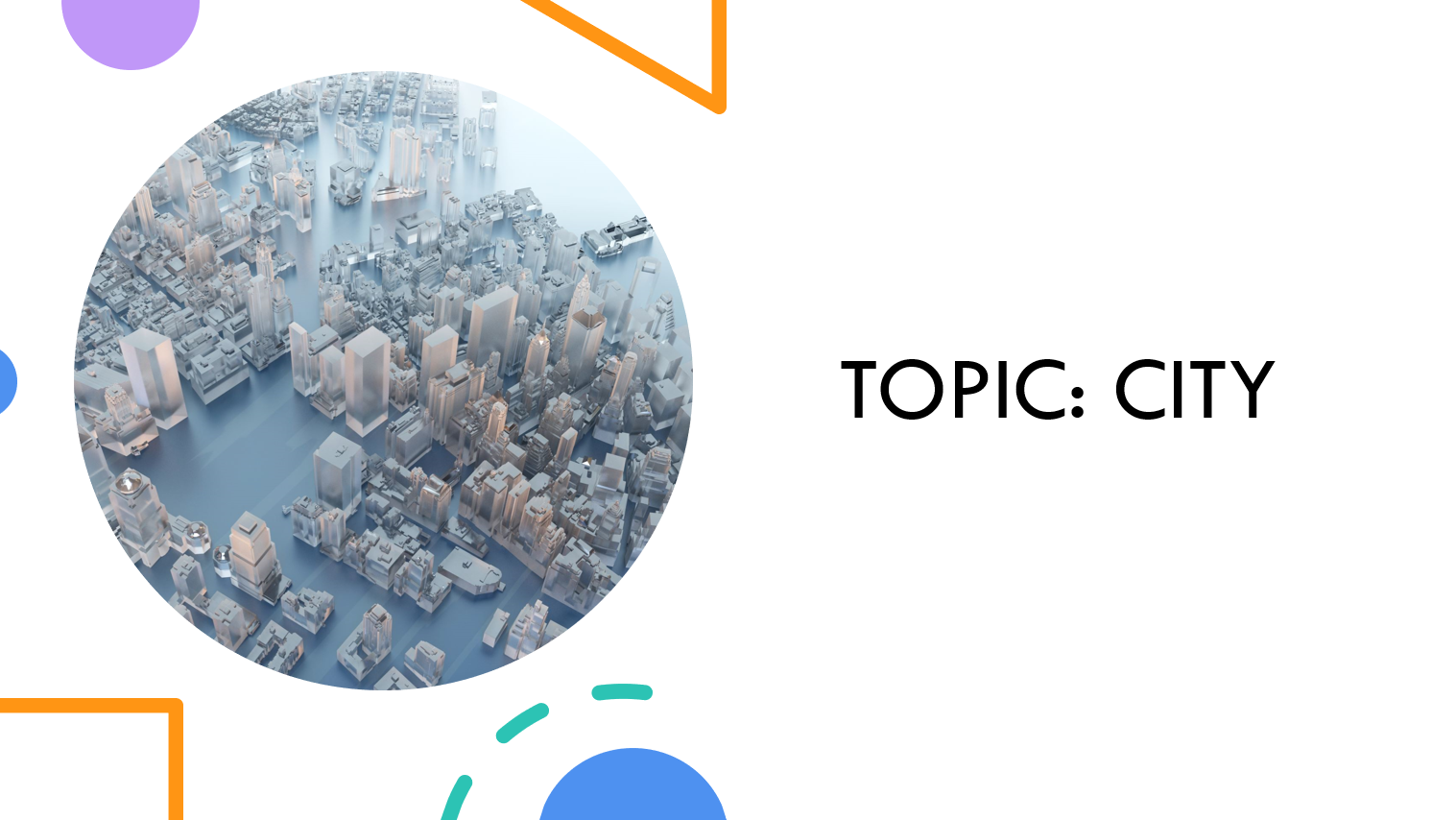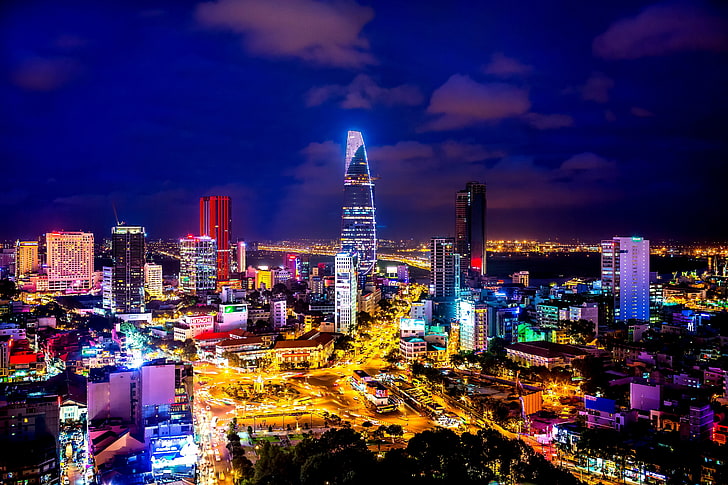Chúng ta hôm nay sẽ cùng nhau khám phá một chủ đề thú vị trong bài mẫu IELTS Speaking Part 3, đó là “City” – một phần quan trọng của cuộc sống hàng ngày và cũng là một trong những chủ đề quen thuộc trong kỳ thi IELTS. Trong phần này, chúng ta sẽ cùng nhau thảo luận và tìm hiểu về các khía cạnh liên quan đến đô thị, từ cảnh quan đến vấn đề xã hội và văn hóa. Điều này sẽ giúp bạn nắm vững kiến thức và tự tin hơn khi đối mặt với phần thi nói trong kỳ thi IELTS.

Mục lục
- 1 Những câu hỏi thường gặp trong chủ đề “City”
- 1.1 Question 1: In many countries there has been large-scale migration from the countryside to the cities. Do you think this is positive or negative?
- 1.2 Question 2: Do you think that the possibility of working from home via the internet will lead to many people going back to the countryside?
- 1.3 Question 3: In what ways do the new megacities of Asia, Africa, and South America differ from older ones such as London or New York?
- 1.4 Question 4: Should there be a limit on the size of cities?
- 1.5 Question 5: Why do people immigrate to other countries?
- 1.6 Question 6: What’s your government’s current policy towards immigration?
- 1.7 Question 7: How can migrants help a country’s economy?
- 1.8 Question 8: Do you like cities generally?
- 1.9 Question 9: Would you like to live in the city you spoke about?
- 1.10 Question 10: How does living in a city compare with living in a small town?
- 1.11 Question 11: How can we encourage more people to use public transport?
- 1.12 Question 12: Do you believe that it should be compulsory to study a foreign language?
- 1.13 Question 13: What role do museums play in our society?
- 1.14 Question 14: How important is sport in the school curriculum?
- 1.15 Question 15: In your opinion what are the most serious problems associated with modern city life?
- 1.16 Question 16: What are the kinds of things people like to do when visiting towns and cities?
- 1.17 Question 17: Why do many people choose to live in cities rather than in the countryside?
- 1.18 Question 18: Can you identify some of the main problems of living in large cities?
- 1.19 Question 19: What measures could be taken to reduce problems of congestion in the cities?
- 2 Tổng kết
Những câu hỏi thường gặp trong chủ đề “City”
Question 1: In many countries there has been large-scale migration from the countryside to the cities. Do you think this is positive or negative?
The large-scale migration from the countryside to cities can have both positive and negative aspects. On one hand, it can lead to urban development, economic growth, and improved access to education and healthcare. On the other hand, it can result in overcrowding, inadequate infrastructure, and challenges related to pollution and social inequality.
Useful phrases/collocations
- Urban development: Phát triển đô thị
- Economic growth: Tăng trưởng kinh tế
- Improved access to: Cải thiện tiếp cận
- Inadequate infrastructure: Hạ tầng không đủ
- Challenges related to: Thách thức liên quan đến
- Social inequality: Bất bình đẳng xã hội
Question 2: Do you think that the possibility of working from home via the internet will lead to many people going back to the countryside?
The possibility of remote work via the internet could encourage some people to relocate to the countryside. It offers a chance to escape the hustle of urban life while maintaining employment. However, this trend might not lead to a significant mass migration, as urban amenities, job opportunities, and cultural attractions often remain concentrated in cities.
Useful phrases/collocations
- Remote work: Làm việc từ xa
- Hustle of urban life: Sự hối hả của cuộc sống đô thị
- Job opportunities: Cơ hội việc làm
- Cultural attractions: Những điểm thu hút về văn hóa
- Concentrated in cities: Tập trung ở thành phố
Question 3: In what ways do the new megacities of Asia, Africa, and South America differ from older ones such as London or New York?
New megacities in Asia, Africa, and South America often face different challenges and exhibit unique characteristics compared to older cities like London or New York. They might experience rapid population growth, informal settlements, and limited infrastructure. In contrast, older cities might have well-established systems, historical significance, and urban planning frameworks in place.
Useful phrases/collocations
- Informal settlements: Khu định cư không chính thức
- Limited infrastructure: Hạ tầng hạn chế
- Well-established systems: Hệ thống được thiết lập tốt
- Historical significance: Ý nghĩa lịch sử
- Urban planning frameworks: Khung cảnh quy hoạch đô thị
- Exhibit unique characteristics: Thể hiện đặc điểm riêng
Question 4: Should there be a limit on the size of cities?
Whether there should be a limit on the size of cities is a complex question. Some argue that limits can prevent issues like congestion, pollution, and strain on resources. However, others believe that cities can continue to grow sustainably with effective urban planning and infrastructure development.
Useful phrases/collocations
- Prevent issues: Ngăn chặn vấn đề
- Congestion: Sự tắc nghẽn
- Strain on resources: Sự căng thẳng về nguồn tài nguyên
- Grow sustainably: Phát triển bền vững
- Urban planning: Quy hoạch đô thị
- Infrastructure development: Phát triển hạ tầng
Question 5: Why do people immigrate to other countries?
People immigrate to other countries for various reasons. These include seeking better economic opportunities, escaping political instability, pursuing education or professional growth, reuniting with family, and experiencing different cultures. Immigration can offer a chance for a new beginning and a higher quality of life.
Useful phrases/collocations
- Economic opportunities: Cơ hội kinh tế
- Political instability: Sự bất ổn chính trị
- Pursuing education: Theo đuổi giáo dục
- Professional growth: Sự phát triển chuyên môn
- Reuniting with family: Hòa nhập với gia đình
- Quality of life: Chất lượng cuộc sống
Question 6: What’s your government’s current policy towards immigration?
My government’s current policy towards immigration focuses on maintaining a balance between welcoming skilled immigrants who contribute to the economy and ensuring proper security measures. The policy also emphasizes family reunification and cultural diversity, while addressing concerns related to illegal immigration and the integration of newcomers.
Useful phrases/collocations
- Welcoming skilled immigrants: Chào đón người nhập cư có kỹ năng
- Contribute to the economy: Đóng góp vào kinh tế
- Security measures: Biện pháp bảo mật
- Family reunification: Hòa nhập gia đình
- Cultural diversity: Đa dạng văn hóa
- Integration of newcomers: Hòa nhập người mới đến
Question 7: How can migrants help a country’s economy?
Migrants can contribute significantly to a country’s economy by filling labor gaps, bolstering workforce diversity, and bringing new skills and perspectives. They often take up jobs that locals might not readily accept, thereby driving economic growth and innovation. Their consumption and entrepreneurial endeavors also stimulate various sectors of the economy.
Useful phrases/collocations
- Filling labor gaps: Bổ sung khoảng trống lao động
- Bolstering workforce diversity: Tăng cường đa dạng lực lượng lao động
- Bringing new skills: Mang lại những kỹ năng mới
- Driving economic growth: Thúc đẩy tăng trưởng kinh tế
- Entrepreneurial endeavors: Nỗ lực kinh doanh sáng tạo
- Stimulate various sectors: Kích thích các ngành khác nhau
Question 8: Do you like cities generally?

Yes, I generally like cities. They offer a plethora of opportunities for cultural exploration, entertainment, education, and professional growth. However, I also recognize the challenges that come with urban living, such as congestion and pollution. Despite the drawbacks, the vibrancy and dynamic nature of cities appeal to me.
Useful phrases/collocations
- Plethora of opportunities: Vô số cơ hội
- Cultural exploration: Khám phá văn hóa
- Entertainment: Giải trí
- Professional growth: Sự phát triển chuyên nghiệp
- Vibrancy: Sự sôi động
- Dynamic nature: Bản chất năng động
Question 9: Would you like to live in the city you spoke about?
Yes, I would like to live in the city I mentioned. Its blend of modern amenities, cultural diversity, and vibrant atmosphere makes it an appealing place to reside. The city’s opportunities for education and career advancement align with my goals, and its rich history and landmarks offer a unique living experience.
Useful phrases/collocations
- Blend of modern amenities: Sự kết hợp giữa tiện ích hiện đại
- Cultural diversity: Đa dạng văn hóa
- Vibrant atmosphere: Bầu không khí sôi động
- Education and career advancement: Giáo dục và thăng tiến sự nghiệp
- Rich history: Lịch sử phong phú
- Landmarks: Những địa danh nổi tiếng
Question 10: How does living in a city compare with living in a small town?
Living in a city offers more conveniences, cultural activities, and career opportunities compared to living in a small town. However, cities often come with higher costs of living, congestion, and noise. Small towns provide a quieter, more close-knit community, but might have limited access to certain amenities and professional prospects.
Useful phrases/collocations
- Conveniences: Tiện nghi
- Cultural activities: Hoạt động văn hóa
- Career opportunities: Cơ hội nghề nghiệp
- Costs of living: Chi phí sinh sống
- Close-knit community: Cộng đồng thân thiết
- Limited access to: Tiếp cận hạn chế đến
Question 11: How can we encourage more people to use public transport?
Encouraging more people to use public transport involves improving its accessibility, affordability, and efficiency. Offering incentives such as reduced fares, dedicated lanes, and integrated payment systems can attract commuters. Educating the public about the environmental benefits and reduced traffic congestion can also promote the use of public transportation.
Useful phrases/collocations
- Accessibility: Khả năng tiếp cận
- Affordability: Khả năng chi trả
- Efficiency: Hiệu suất
- Reduced fares: Giá vé giảm
- Dedicated lanes: Làn đường riêng
- Integrated payment systems: Hệ thống thanh toán tích hợp
Question 12: Do you believe that it should be compulsory to study a foreign language?
Yes, I believe that studying a foreign language should be compulsory. Learning a new language enhances cultural understanding, communication skills, and cognitive development. It fosters global awareness and opens up opportunities for cross-cultural interactions, which are crucial in our interconnected world.
Useful phrases/collocations
- Enhances cultural understanding: Nâng cao hiểu biết văn hóa
- Communication skills: Kỹ năng giao tiếp
- Cognitive development: Phát triển nhận thức
- Fosters global awareness: Khuyến khích nhận thức toàn cầu
- Cross-cultural interactions: Tương tác đa văn hóa
- Interconnected world: Thế giới liên kết
Question 13: What role do museums play in our society?

Museums play a crucial role in preserving cultural heritage, educating the public, and fostering a sense of identity and connection with the past. They provide a space for artistic and historical exploration, enabling individuals to learn about diverse cultures and reflect on the evolution of human history and achievements.
Useful phrases/collocations
- Preserving cultural heritage: Bảo tồn di sản văn hóa
- Educating the public: Giáo dục công chúng
- Fostering a sense of identity: Tạo dựng ý thức về bản sắc
- Artistic and historical exploration: Khám phá nghệ thuật và lịch sử
- Diverse cultures: Những văn hóa đa dạng
- Evolution of human history: Sự phát triển của lịch sử nhân loại
Question 14: How important is sport in the school curriculum?
Sport is highly important in the school curriculum as it promotes physical health, teamwork, discipline, and leadership skills. Engaging in sports fosters a balanced lifestyle, teaches valuable life lessons, and enhances students’ overall well-being. It encourages social interaction and instills qualities that are essential for personal and professional success.
Useful phrases/collocations
- Promotes physical health: Khuyến khích sức khỏe cơ thể
- Teamwork: Làm việc nhóm
- Discipline: Kỷ luật
- Leadership skills: Kỹ năng lãnh đạo
- Balanced lifestyle: Lối sống cân đối
- Overall well-being: Sức khỏe tổng thể
Question 15: In your opinion what are the most serious problems associated with modern city life?
In my opinion, some of the most serious problems associated with modern city life include pollution, traffic congestion, high cost of living, social isolation, and mental health challenges. These issues can impact people’s quality of life and require comprehensive strategies for mitigation and improvement.
Useful phrases/collocations
- Pollution: Ô nhiễm
- Traffic congestion: Tắc nghẽn giao thông
- High cost of living: Chi phí sinh sống cao
- Social isolation: Cô lập xã hội
- Mental health challenges: Thách thức về tâm lý
- Comprehensive strategies: Chiến lược toàn diện
Question 16: What are the kinds of things people like to do when visiting towns and cities?
When visiting towns and cities, people often enjoy exploring cultural landmarks, trying local cuisine, shopping for unique products, and attending cultural events. They might also engage in recreational activities, visit museums, and interact with local residents to experience the authentic essence of the place.
Useful phrases/collocations
- Exploring cultural landmarks: Khám phá điểm tham quan văn hóa
- Trying local cuisine: Thử nếm đặc sản địa phương
- Shopping for unique products: Mua sắm sản phẩm độc đáo
- Attending cultural events: Tham dự sự kiện văn hóa
- Recreational activities: Hoạt động giải trí
- Authentic essence: Bản chất chân thực của nơi đó
Question 17: Why do many people choose to live in cities rather than in the countryside?
Many people opt to live in cities due to the allure of better job opportunities, access to education and healthcare, cultural amenities, and a dynamic lifestyle. Cities offer a variety of social and entertainment options that can be less available in rural areas. Additionally, urban living can provide a sense of anonymity and greater exposure to diverse experiences.
Useful phrases/collocations
- Allure of better job opportunities: Hấp dẫn từ cơ hội việc làm tốt hơn
- Access to education and healthcare: Tiếp cận giáo dục và chăm sóc sức khỏe
- Cultural amenities: Tiện ích văn hóa
- Dynamic lifestyle: Lối sống năng động
- Social and entertainment options: Lựa chọn xã hội và giải trí
- Sense of anonymity: Cảm giác ẩn danh
Question 18: Can you identify some of the main problems of living in large cities?
Some of the main problems of living in large cities include traffic congestion, air and noise pollution, high living costs, overcrowding, and increased stress levels. These challenges can impact residents’ physical and mental well-being and necessitate urban planning and sustainable solutions.
Useful phrases/collocations
- Traffic congestion: Tắc nghẽn giao thông
- Air and noise pollution: Ô nhiễm không khí và tiếng ồn
- High living costs: Chi phí sinh sống cao
- Overcrowding: Sự quá tải
- Increased stress levels: Tăng mức độ căng thẳng
- Urban planning: Quy hoạch đô thị
Question 19: What measures could be taken to reduce problems of congestion in the cities?
To mitigate congestion problems in cities, measures such as developing efficient public transport systems, promoting carpooling, implementing congestion pricing, and creating pedestrian-friendly zones can be effective. Additionally, urban planning that prioritizes mixed land use and encourages alternative modes of transportation can alleviate congestion.
Useful phrases/collocations
- Developing efficient public transport systems: Phát triển hệ thống giao thông công cộng hiệu quả
- Promoting carpooling: Khuyến khích chia xe
- Implementing congestion pricing: Thực hiện giá cảng chật
- Pedestrian-friendly zones: Khu vực thân thiện với người đi bộ
- Mixed land use: Sự sử dụng đất đa dạng
- Alternative modes of transportation: Các phương tiện giao thông thay thế
Xem thêm các Topic IELTS Speaking Part 3 khác TẠI ĐÂY
Tổng kết
Chúng ta đã cùng nhau trải qua một hành trình thú vị trong việc khám phá chủ đề “City” qua bài mẫu IELTS Speaking Part 3 tại Hà English. Thông qua việc thảo luận về các khía cạnh của đô thị như môi trường sống, văn hóa, giao thông và nhiều khía cạnh khác, chúng ta đã có cái nhìn sâu hơn về sự đa dạng và phức tạp của cuộc sống đô thị.
Nếu bạn đang tìm kiếm một trung tâm Anh ngữ uy tín và chất lượng, Hà English là một sự lựa chọn tuyệt vời. Với hơn 10 năm kinh nghiệm trong lĩnh vực giảng dạy tiếng Anh, trung tâm đã đạt được uy tín cao trong việc đào tạo học viên về ngoại ngữ.

Hà English tự hào là một môi trường học tập chuyên nghiệp và thân thiện, với đội ngũ giáo viên có trình độ cao và giàu kinh nghiệm. Những giảng viên tại trung tâm không chỉ sở hữu kiến thức chuyên môn vững vàng mà còn có khả năng tạo động lực và sự hứng thú trong quá trình học tập của học viên.
Dạy từ tâm – nâng tầm tri thức
Đăng kí tư vấn nhận lộ trình học phù hợp từ Hà English ngay!
